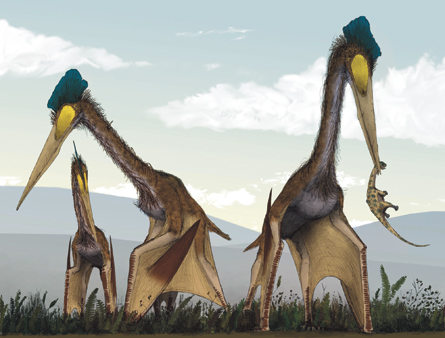PITTSBURGH — Predating jet travel by at least 65 million years wasn’t a problem for the biggest pterosaurs. These prehistoric creatures might have been able to fly up to 10,000 miles nonstop, according to research presented October 10 at the annual meeting of the Society of Vertebrate Paleontology.

The original elite flyers included four species of what biomechanist Michael Habib, of Chatham University in Pittsburgh, calls supergiant pterosaurs: flying reptiles such as Quetzalcoatlus northropi from Texas. Appearing in the fossil record 70 million years ago, they stood about as tall as a modern giraffe and launched into the air spreading membrane wings to a total span of roughly 10 meters.
These supergiants “are big by pterosaur standards,” Habib said. “They are truly gruesomely huge by bird and bat standards.”
If current estimates for pterosaur body masses and wing dimensions are realistic, and if the pterosaurs could catch thermals and glide the way a bird can, “it would make them the longest single-trip-distance fliers in the Earth’s history,” Habib said. Birds have logged impressive distances considering their small size, such as Arctic terns that basically migrate pole to pole, but birds don’t do so in one go.
The new pterosaur calculations raise the possibility that the supergiant fossils found on separate continents can’t automatically be considered different species, Habib suggested. “A pterosaur from Big Bend could be mating with a pterosaur from Transylvania,” he said.
Huge distances for non-stop travel may sound extreme, said David Unwin, a pterosaur researcher at the University of Leicester in England, but “we didn’t fall on the floor laughing” hearing of the idea. Unwin said he welcomes the new figures for at last providing some specifics for discussion.
As for merging any currently misunderstood species, though, he’s less sanguine. The pterosaur fossil record is patchy, and big gaps between specimens suggest that they must be different species, he said.
Also controversial are the basics, such as body mass, that Habib put into his new distance calculations. Habib said he picked estimates yielded by quantitative approaches taken by other researchers. If a pterosaur weighed 200 kilograms “empty,” plus another 72 kilograms of fat to fuel a long trip, Habib calculated that the animal could soar 10,000 miles nonstop.
For that calculation, Habib tuned his calculations for wings shaped roughly like modern eagles’. Their wings, he said, represent a compromise between a long narrow shape for gliding and a wide wing for heavy lifting.
And yes, Habib said, pterosaurs that heavy really could haul their substantial rumps into the air. Warm Cretaceous temperatures might have given them more thermals to ride, but to be conservative he made them fly in a modern atmosphere. He assumed that pterosaurs could mostly soar between brief bursts of flapping, and he borrowed analytic methods from bird studies to estimate how far fat supplies would take them. Habib got long distances when assuming a metabolic rate about 85 percent that of modern birds.
Even if the different assumptions about weight or wing shape shrink or extend the distance calculations, the bottom line remains the same, Habib said. “What’s important is that the numbers are all big.”






